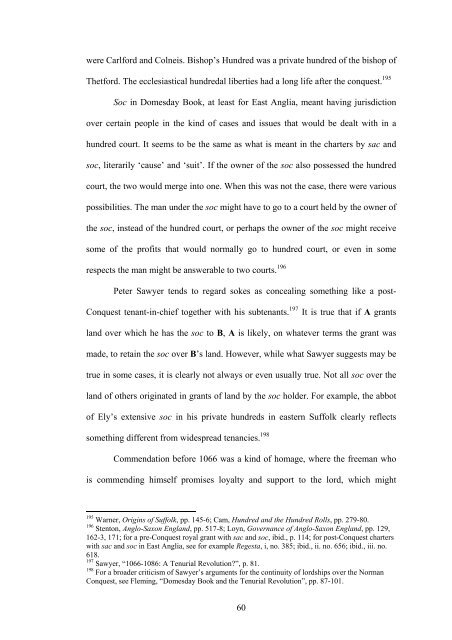I certify that I have read this thesis and have ... - Bilkent University
I certify that I have read this thesis and have ... - Bilkent University
I certify that I have read this thesis and have ... - Bilkent University
Create successful ePaper yourself
Turn your PDF publications into a flip-book with our unique Google optimized e-Paper software.
were Carlford <strong>and</strong> Colneis. Bishop’s Hundred was a private hundred of the bishop of<br />
Thetford. The ecclesiastical hundredal liberties had a long life after the conquest. 195<br />
Soc in Domesday Book, at least for East Anglia, meant having jurisdiction<br />
over certain people in the kind of cases <strong>and</strong> issues <strong>that</strong> would be dealt with in a<br />
hundred court. It seems to be the same as what is meant in the charters by sac <strong>and</strong><br />
soc, literarily ‘cause’ <strong>and</strong> ‘suit’. If the owner of the soc also possessed the hundred<br />
court, the two would merge into one. When <strong>this</strong> was not the case, there were various<br />
possibilities. The man under the soc might <strong>have</strong> to go to a court held by the owner of<br />
the soc, instead of the hundred court, or perhaps the owner of the soc might receive<br />
some of the profits <strong>that</strong> would normally go to hundred court, or even in some<br />
respects the man might be answerable to two courts. 196<br />
Peter Sawyer tends to regard sokes as concealing something like a post-<br />
Conquest tenant-in-chief together with his subtenants. 197 It is true <strong>that</strong> if A grants<br />
l<strong>and</strong> over which he has the soc to B, A is likely, on whatever terms the grant was<br />
made, to retain the soc over B’s l<strong>and</strong>. However, while what Sawyer suggests may be<br />
true in some cases, it is clearly not always or even usually true. Not all soc over the<br />
l<strong>and</strong> of others originated in grants of l<strong>and</strong> by the soc holder. For example, the abbot<br />
of Ely’s extensive soc in his private hundreds in eastern Suffolk clearly reflects<br />
something different from widesp<strong>read</strong> tenancies. 198<br />
Commendation before 1066 was a kind of homage, where the freeman who<br />
is commending himself promises loyalty <strong>and</strong> support to the lord, which might<br />
195 Warner, Origins of Suffolk, pp. 145-6; Cam, Hundred <strong>and</strong> the Hundred Rolls, pp. 279-80.<br />
196 Stenton, Anglo-Saxon Engl<strong>and</strong>, pp. 517-8; Loyn, Governance of Anglo-Saxon Engl<strong>and</strong>, pp. 129,<br />
162-3, 171; for a pre-Conquest royal grant with sac <strong>and</strong> soc, ibid., p. 114; for post-Conquest charters<br />
with sac <strong>and</strong> soc in East Anglia, see for example Regesta, i, no. 385; ibid., ii. no. 656; ibid., iii. no.<br />
618.<br />
197 Sawyer, “1066-1086: A Tenurial Revolution?”, p. 81.<br />
198 For a broader criticism of Sawyer’s arguments for the continuity of lordships over the Norman<br />
Conquest, see Fleming, “Domesday Book <strong>and</strong> the Tenurial Revolution”, pp. 87-101.<br />
60
















